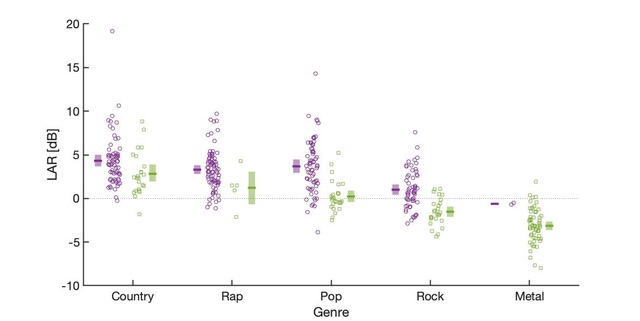From the Journal: JASA Express Letters
WASHINGTON, April 25, 2023 – A general rule of music production involves mixing various soundtracks so the lead singer’s voice is in the foreground. But it is unclear how such track mixing – and closely related lyric intelligibility – has changed over the years.
Scientists from the University of Oldenburg in Germany carried out an analysis of hundreds of popular song recordings from 1946 to 2020 to determine the lead vocal to accompaniment ratio, or LAR. Their results appear in JASA Express Letters, published on behalf of the Acoustical Society of America by AIP Publishing, and show that, contrary to expectations, the LAR for popular music decreased over the decades in question. This means that, relative to their bands, lead singers are getting quieter.
An earlier study suggested that lead vocals were mixed at a higher level than other instruments, but it looked at songs that were not fully representative of popular Western music. The current study rectified this by considering the four highest-ranked songs from the Billboard Hot 100 chart for each year from 1946 to 2020.
“Due to their diversity, the Billboard Charts are considered independent and representative,” said author Karsten Gerdes.

The resulting database of 300 songs was studied by separating vocals from the mixture of sounds in each recording. Since most recordings are not available as multiple tracks, software was used to separate each song into four tracks: vocals, bass, percussion (drums), and all remaining sounds. In some cases, background singers were part of the recording, so the investigators developed a way to remove the influence of backing vocals and measure only on the lead singer level.
“Our analysis showed a significant downward trend in the LAR from about 5 decibels in 1946 to approximately 1 decibel in 1975, after which time the LAR remained constant,” Gerdes said.
The investigators wished to determine whether LAR values changed over time to improve the intelligibility of lyrics or if changes in music technology were involved. Electrical amplification of instruments might, for example, be a factor, as could multitrack and stereophonic recording technology. They found that changes in music technology appear to be behind the observed decrease in LAR until 1975.
“Another possibility involves the stylistic evolution within popular music,” author Kai Siedenburg said.
To test this last idea, the investigators carried out a study of genre dependence by considering songs nominated for Grammy Awards in the genres of country, rap, pop, rock, and metal. As might be expected, country had the highest LAR, followed by rap and pop. The LAR was near zero for rock, negative for metal, and significantly higher for solo artists versus bands. Sound amplitudes were computed by subtracting them from the maximum of the lead vocal, which is why some results were negative.
“Guitar riffs are a distinctive feature of rock and metal, with guitars taking a position comparable to lead vocals,” Siedenburg said.
This interpretation was confirmed by computing a similar figure, the guitar-to-accompaniment ratio, GAR. For metal, the GAR was found to be a positive number almost equal to the LAR for pop music.
###
Article Title
Lead-vocal level in recordings of popular music 1946-2020
Authors
Karsten Gerdes and Kai Siedenburg
Author Affiliations
University of Oldenburg
